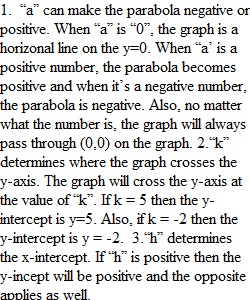


Q Investigate the Graphs of Quadratic Functions In this activity you will investigate the graphs of quadratic functions in the form f(x) = a(x - h)2 + k You will be assessing the changes in both the shape and position of the graph. Procedures ? Go to the Desmos online graphing calculator. Link: https://www.desmos.com/calculator/ • In the first space on the left type in the equation above. ? Click on “all sliders” to enable them. You can now adjust the values of a, h, and k manually. First focus on a. ? Set both h and k to zero. Change the value of a (make it both positive and negative). 1. On your paper describe in complete sentences how a affects the shape and position of the graph. Please describe all the noticeable effects as clearly as you can. Now focus on k. ? Set a = 1 and h = 0. Change the value of k (make it both positive and negative). 2. On your paper describe in complete sentences how k affects the shape and position of the graph. Please describe all the noticeable effects as clearly as you can. Focus on h. ? Set both a =1 and k = 0. Change the value of h (make it both positive and negative). 3. On your paper describe in complete sentences how h affects the shape and position of the graph. Please describe all the noticeable effects as clearly as you can.
View Related Questions